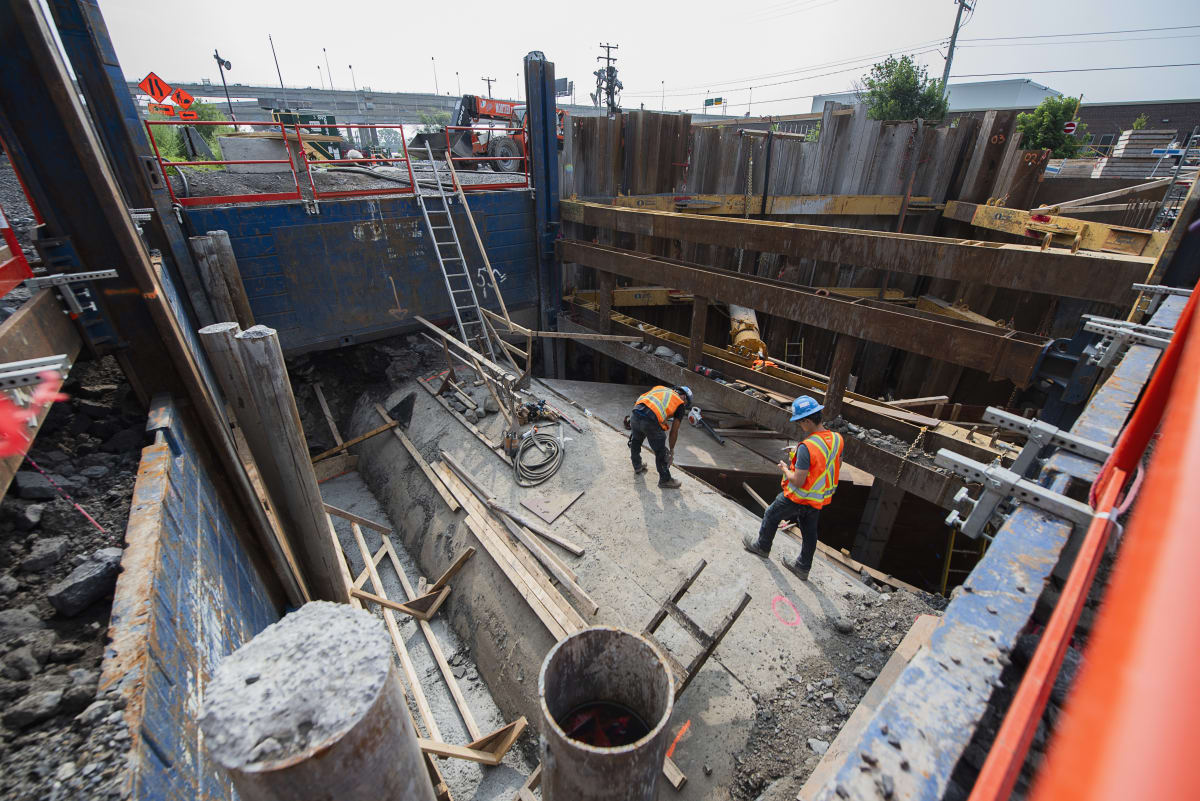Retention structures: Limiting wastewater discharge
The city is building retention structures, which are underground structures that reduce sewer backup and prevent wastewater from being discharged into our waterways.
Why build retention structures?
Retention structures reduce the risk of wastewater overflowing into waterways and natural environments. They also increase the service capacity sewer systems. These reservoirs temporarily store wastewater. When the time is right, or when water flow returns to normal, the water stored in the reservoirs is redirected into the waterworks system and onward to the wastewater treatment plant, where it is treated.
The benefits:
Reduced discharge of wastewater into waterways, thereby improving water quality. This reduces environmental impacts and encourages recreational activities on these waterways.
Increase the capacity of the sewer system to respond to the impacts of extreme weather events related to climate change.
Reduce the risk of sewer backups.
How are they built?
There are several types of retention structures. The main ones include surface bodies of water, basins or lakes; underground reinforced concrete retention basins with or without pumping stations; and oversized sewer pipes for water retention.
Building these structures is a major undertaking, and the project can take 2 or 3 years to complete. When the structure is large and very deep, the city must sometimes use explosives to excavate the rock. In such cases, the following measures are implemented:
Preventive inspection of buildings in the vicinity of the construction site, using photo or video surveys before and after work begins.
Installation of measuring instruments in and around the site to limit noise and vibrations caused by blasting. Data is then monitored to ensure compliance with standards.
After excavation, the contractor begins building the retention structure. Once completed, the structure is connected to the existing sewer system. It is then integrated into the waterworks system and routed to the Jean-R. Marcotte wastewater treatment plant.
Examples of new structures
The Lavigne basin
The Lavigne retention basin is located beneath Parc Lefebvre in the Ahuntsic-Cartierville borough. With a retention capacity of 20,000 square metres — the equivalent of 8 Olympic-sized swimming pools — it reduces the volume of wastewater discharged into the Rivière des Prairies and improves the level of service provided by the Gouin collector. Nearly 2 linear km of pipes were tunnelled through bedrock to connect to the existing sewer system.
Watch this video about how the Lavigne basin was built and learn more about the scope of such projects (in French).
The Rockfield basin
The Rockfield retention basin under construction in LaSalle will be able to capture up to 16 m³ (16,000 litres) of water every second during periods of heavy rainfall. The huge underground reservoir can hold up to 45,000 cubic metres of water (about 15 Olympic-sized swimming pools), which will then be treated gradually as the sewer system recovers its capacity. Once completed, the Rockfield retention basin will be the largest in Montréal.
Did you know?
Before the Rockfield retention basin was built, overflows into the Lachine Canal might occur 5 to 6 times a year. Once the Rockfield basin opens, this situation is expected to occur only exceptionally, approximately every 5 years.
William retention basin
The William retention basin, which is located beneath Parc Mary-Griffin in Griffintown (Le Sud-Ouest), is the world’s largest retention structure built of fiberglass-reinforced polyester pipes!
The impressive pipes, with diameters of 3.3 m and 3.6 m, were imported from Europe by ship, then delivered by special trucks to the heart of the city. Thanks to this technical innovation, the pipes were designed and laid faster than the traditional concrete method, while reducing the need for concrete mixers in the neighbourhood.
Its capacity will relieve the sewer system of 12,000 cubic metres of water during heavy rains, reducing overflows to the river and preventing possible sewer backups.
Other retention structures
Montréal has a network of retention basins throughout the island. A total of nearly 49 million liters of water can be captured, preventing direct overflow into natural waterways.
Quick search
Need help?
Contact us if you have questions.
Are you sure you want to leave this page?
This page is not available in English. You will be redirected to the English home page.





